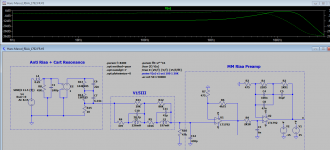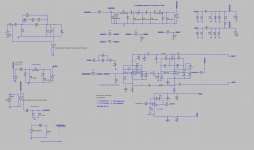Now what about supplies for this RIAA preamp?
My inclination is toward using Jung/Didden supplies that I will assemble myself.
For a time I did consider 3X7 supplies with denoizators (hopefully everybody knows what I'm talking about) but I have read scarce feedbacks on how it affects the audio quality.
Other options seems to be LT3042/45 power supplies, but assembled ones come not cheap. And my experience with SMD parts is close to none.
What are your opinions on this matter?
My inclination is toward using Jung/Didden supplies that I will assemble myself.
For a time I did consider 3X7 supplies with denoizators (hopefully everybody knows what I'm talking about) but I have read scarce feedbacks on how it affects the audio quality.
Other options seems to be LT3042/45 power supplies, but assembled ones come not cheap. And my experience with SMD parts is close to none.
What are your opinions on this matter?
Yes, I already got in contact with Bill and he suggested for me to send the photos.
Better yet would be to find the original Grado box.
Better yet would be to find the original Grado box.
I am a fan of Jan's silentswitcher, but aware I am into advanced **** polishing with that as Hans and Syn08 have proven.
If the current consumption is below say 20mA (you could always parallel the two halves in a dual to get 40mA) the LM4562 makes a superb linear reg. PSRR at LF >110 dB and its still 80 dB at 100 kHz and its very low noise (pV/rt Hz).
If the current consumption is below say 20mA (you could always parallel the two halves in a dual to get 40mA) the LM4562 makes a superb linear reg. PSRR at LF >110 dB and its still 80 dB at 100 kHz and its very low noise (pV/rt Hz).
What linear regulator would be that? I would like to simulate it in LTSPice and compare it to the others.
As op-amps have a pretty good PSRR at low frequencies, plain old 78xx/79xx supplies should work fine - but using something fancier won't do any harm, of course.
My comparisons between 78XX/79XX and 3X7 in the '80s and later went very bad for the former, always.
The LM4562is a dual opamp.
You can use the LM4562 to regulate down to lower voltage for example, if your preamp needs say 12 V down from 18V. A simple decoupled voltage divider is good enough to serve as a reference input and you can expect about 1 uV wide band noise at the output.
Don’t discount the 78xx/79xx regulators. They are lower noise than the 317/337 and if you use the split supply trick, you can use a 78xx to create both + and - rails. As Marcel mentioned, the PSRR on modern opamps is very good, so a few tens of uV ripple on the supply rail ends up being a very small when referred to the input. The wide band noise on a 7815 is about 150 uV vs 350+ uV for a 317.
Another very low noise option (7uV wide band noise IIRC) is the LM723 - still going strong after 40 years.
You can use the LM4562 to regulate down to lower voltage for example, if your preamp needs say 12 V down from 18V. A simple decoupled voltage divider is good enough to serve as a reference input and you can expect about 1 uV wide band noise at the output.
Don’t discount the 78xx/79xx regulators. They are lower noise than the 317/337 and if you use the split supply trick, you can use a 78xx to create both + and - rails. As Marcel mentioned, the PSRR on modern opamps is very good, so a few tens of uV ripple on the supply rail ends up being a very small when referred to the input. The wide band noise on a 7815 is about 150 uV vs 350+ uV for a 317.
Another very low noise option (7uV wide band noise IIRC) is the LM723 - still going strong after 40 years.
Last edited:
I don't remember what the noise was in the 78XX/79XX in Wal Jung's spec comparison when he designed his regulator.
The sound quality I got with the 3X7 was much better and definitely an improvement over the 78XX/79XX when I proved it.
I think I have a preamp kit where they use dual opamp as regulator the way tou describe. I thought you were proposing using the LM4562 for a dual Jung regulator. That is what I'm more interested in.
The sound quality I got with the 3X7 was much better and definitely an improvement over the 78XX/79XX when I proved it.
I think I have a preamp kit where they use dual opamp as regulator the way tou describe. I thought you were proposing using the LM4562 for a dual Jung regulator. That is what I'm more interested in.
Correction, the wide band noise on the LM7815 is about 90uV - pretty good for a work horse regulator.
Beware the ST L78xx regulators which appear to have about 20x the noise of the LM78xx types. For example the L7818 specified the noise as 110uV/Vo or per Volt out - so close to 2mV wideband output noise on an 18V output reg. Its ripple rejection specs are also not as god as the LM78xx devices (10x worse from what I can tell). It might be this is the reg you used.
Anyway, the Jung reg is well regarded so if you go for this you can't go wrong.
Beware the ST L78xx regulators which appear to have about 20x the noise of the LM78xx types. For example the L7818 specified the noise as 110uV/Vo or per Volt out - so close to 2mV wideband output noise on an 18V output reg. Its ripple rejection specs are also not as god as the LM78xx devices (10x worse from what I can tell). It might be this is the reg you used.
Anyway, the Jung reg is well regarded so if you go for this you can't go wrong.
I found another interesting chip for a RIAA preamp: OPA1611. Pity the input is bipolar, not FET.
But I'm having some trouble making an LTSpice model work.
What do you think Marcel? Would it work for MM in spite of being bipolar? It's quite affordable.
But I'm having some trouble making an LTSpice model work.
What do you think Marcel? Would it work for MM in spite of being bipolar? It's quite affordable.
It would work, but the noise would be somewhat high, as it is one of those ultralow voltage noise, ultrahigh current noise designs. It produces 1.7 pA/sqrt(Hz) of equivalent input noise current, about as much as a 5.7 kohm shunt resistor.
This OPA1611 was suggested to me as a very good option for the Jung Super Regulator, with similar results as the AD797 but without the instability and oscillation problems that chip cause in the Super Reg.
But I seem not get an LTSpice working model for it. Same thing happens with the OPA134, also recommended. Can't make the model work.
But I seem not get an LTSpice working model for it. Same thing happens with the OPA134, also recommended. Can't make the model work.
This reminds me of someone having trouble to get a AD825 working.
Hans
Indeed, Hans. Only this time that way of doing things is not working.
I do not have a .cir or .asy file.
Apparently a different way of doing things has to be applied, right?
Download the zipped OPA1611 Spice model.
Extract the zipped file.
Put the OPA1611.lib in the same directory that you are using for your model.
Follow the same procedure as for the AD825 to auto generate an .ASY file.
In your model click on AutoGenerated and place your OPA1611.
Hans
Extract the zipped file.
Put the OPA1611.lib in the same directory that you are using for your model.
Follow the same procedure as for the AD825 to auto generate an .ASY file.
In your model click on AutoGenerated and place your OPA1611.
Hans
Attachments
Perhaps some of you would find this of interest.
It's an early (simplified) RIAA opamp design which includes models for cartridge/pickup arm behaviors etc. based on measurements of a specific cartridge- the Miyajima Madake.
The full preamp, somewhat modified, extended and improved, is on a thread in this forum.
it also includes a Laplace RIAA model, A weighting measurement networks etc.
It's an early (simplified) RIAA opamp design which includes models for cartridge/pickup arm behaviors etc. based on measurements of a specific cartridge- the Miyajima Madake.
The full preamp, somewhat modified, extended and improved, is on a thread in this forum.
it also includes a Laplace RIAA model, A weighting measurement networks etc.
Attachments
- Home
- Source & Line
- Analogue Source
- RIAA preamps versus real loads


